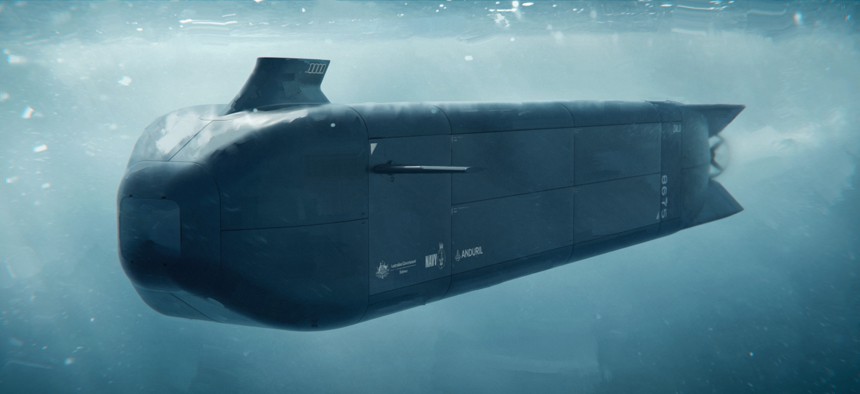
Ghost Shark UUV illustration Anduril
Australia got a new sub drone far faster than the US Navy could have, company says
Anduril says its Ghost Shark proves that UUVs can be designed and built quickly.
Technical details were sparse as Anduril announced a prototype undersea drone in Australia last Thursday, but company officials stressed a different aspect of the effort: its early, under-budget arrival could not have happened for the U.S. Navy.
“It's not an accident that the Ghost Shark program is happening in Australia,” Christian Brose, Anduril chief strategy officer, told reporters. “You know, there just wasn't an opportunity to do this in the United States by virtue of the Navy's program of record. I think what we've proven—or [are] in the process of proving—is these kinds of capabilities can be built much faster, much cheaper, much more intelligently.”
Anduril officials couldn’t even describe the size or potential missions of the Ghost Shark UUV. But they said that they signed a deal with the Royal Australian Navy and Defence Science and Technology Group in May 2022 with a plan to deliver prototypes over the next three years. The plan is to have a manufacture-ready vehicle by mid 2025.
“We've been at sea for some time. We can't say exactly how long but for anyone who is looking closely at the photos from yesterday, there's a lot of dings on the vehicle, which has been swimming for some time,” Shane Arnott, Anduril’s senior vice president engineering, told reporters.
Contrast that with the U.S. Navy, which is also seeking autonomous sub drones. In December, Boeing delivered the first of five ORCA prototypes under the Navy’s Extra Large Unmanned Undersea Vehicles program.. But the program was already three years late and 64 percent over budget in 2022, GAO found. And last April, the Navy canceled another large sub drone competition entirely.
Autonomous sub drones might help deter China, which has more warships and more missiles than the United States in the western Pacific, from invading Taiwan. But doing so would require huge numbers of a wide variety of drones.
Arnott said he was confident that Anduril would be able to produce robot subs in large numbers.
“Scaling has been kind of the central tenet to the program. So we're not just building the three prototypes, but we're also building out the factory,” he said.
Small submarines and sub drones are often “created with quite exotic designs, and typically...in small numbers,” he said. But “we're expecting this to be built in very large numbers. So proving out that supply chain, proving out the production system, has been actually part of this program.”
Ghost Shark isn’t formally part of the AUKUS effort, the U.S.-UK-Australia agreement to jointly build a manned submarine and cooperate on emerging technologies. But Brose said it might be someday.
“Conversations between the Australians and the Americans have been happening. Much of that is happening in government-to-government channels that we're not, officially a part of it. But I think that is now going to accelerate as the Australian government has built up its conviction in this program, you know, is demonstrating its commitment to it,” he said.
